Professional Development of Early Childhood Educators
VerifiedAdded on 2023/01/23
|8
|1988
|81
AI Summary
This paper discusses the professional development of an early childhood professional and the skills they need to enhance their teaching effectiveness. It explores the importance of adaptability, confidence, communication, imagination, leadership, innovation, commitment, continuous learning, and team playing. The paper also discusses different learning styles and the role of reflection in professional development.
Contribute Materials
Your contribution can guide someone’s learning journey. Share your
documents today.
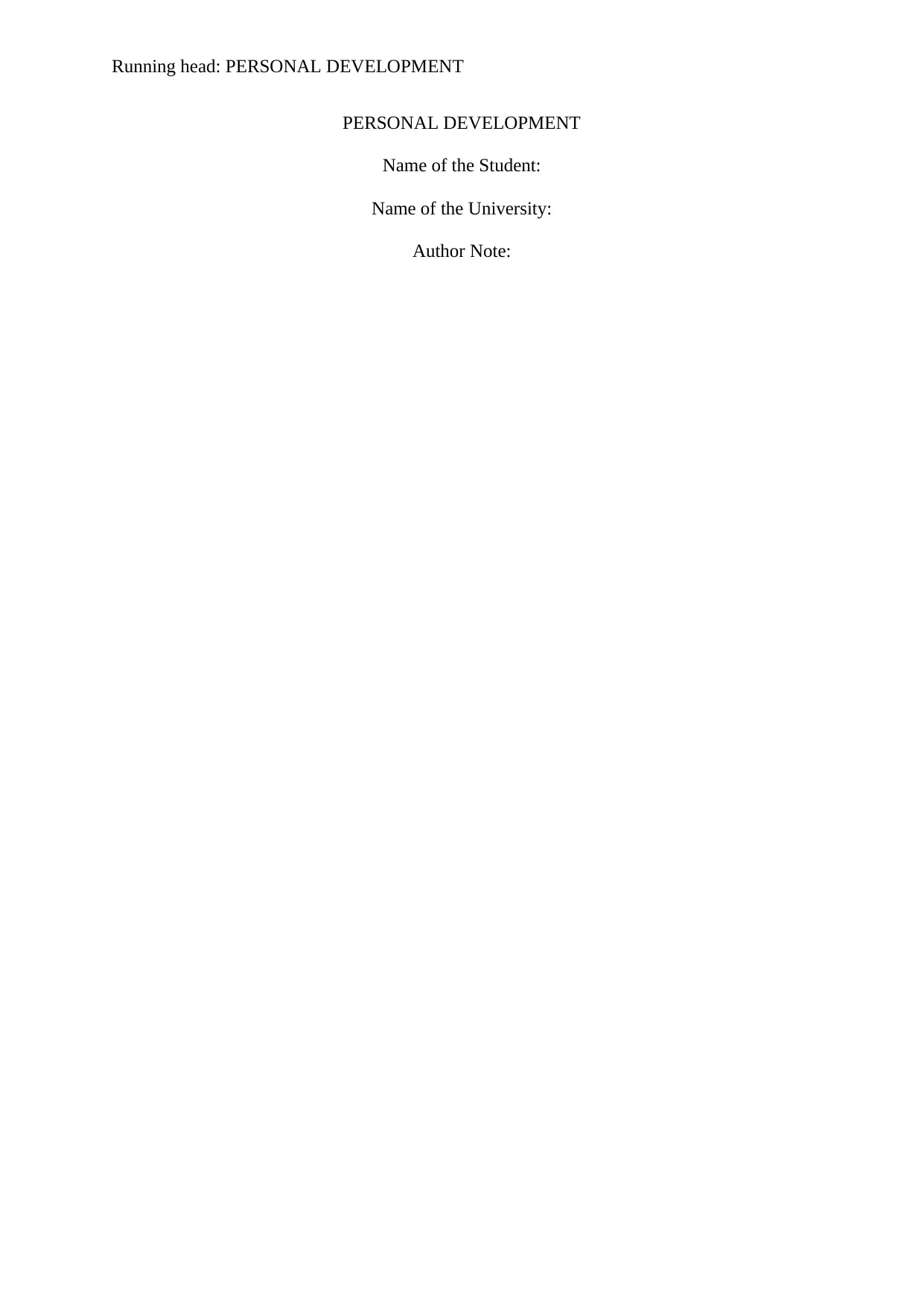
Running head: PERSONAL DEVELOPMENT
PERSONAL DEVELOPMENT
Name of the Student:
Name of the University:
Author Note:
PERSONAL DEVELOPMENT
Name of the Student:
Name of the University:
Author Note:
Secure Best Marks with AI Grader
Need help grading? Try our AI Grader for instant feedback on your assignments.
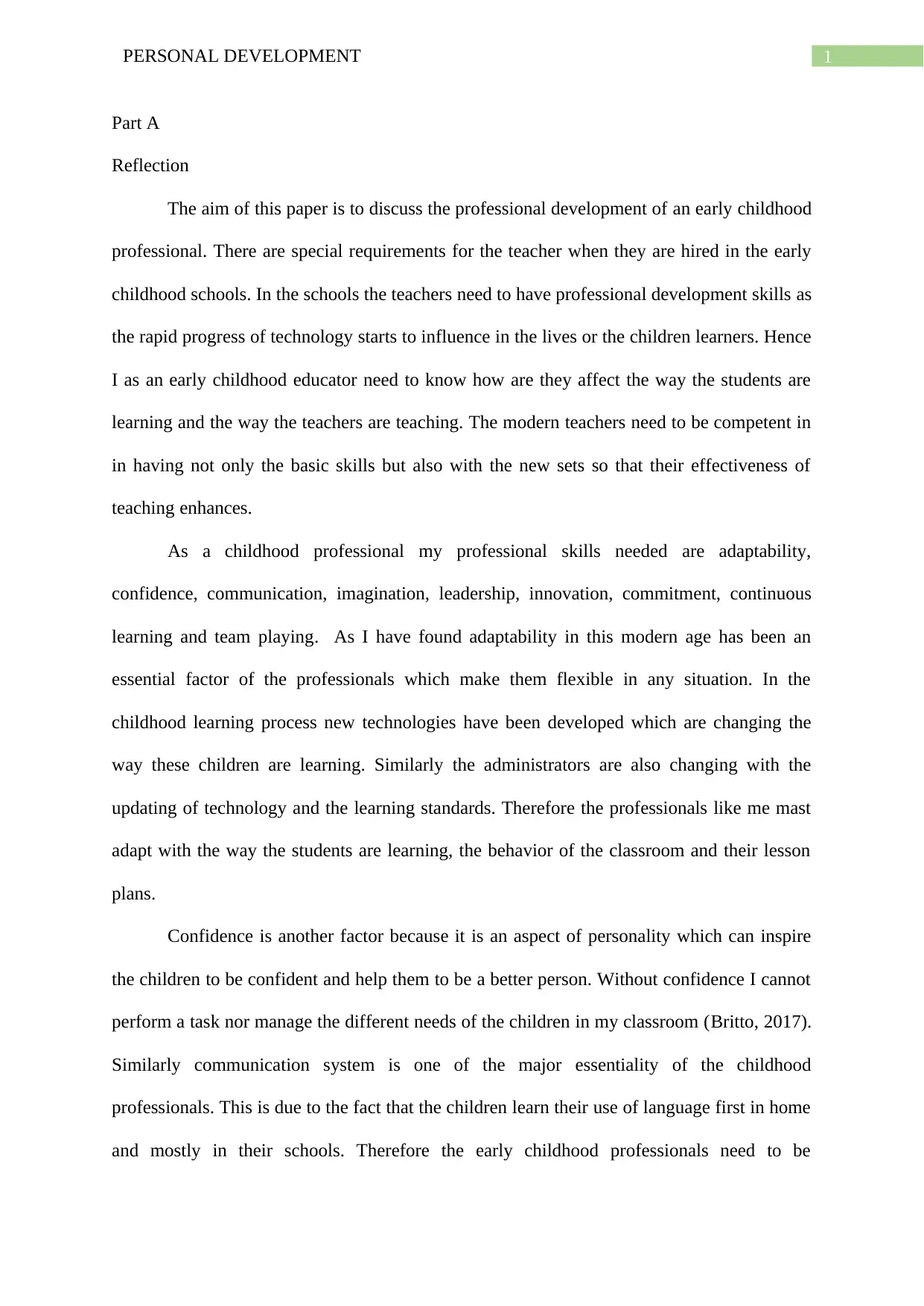
1PERSONAL DEVELOPMENT
Part A
Reflection
The aim of this paper is to discuss the professional development of an early childhood
professional. There are special requirements for the teacher when they are hired in the early
childhood schools. In the schools the teachers need to have professional development skills as
the rapid progress of technology starts to influence in the lives or the children learners. Hence
I as an early childhood educator need to know how are they affect the way the students are
learning and the way the teachers are teaching. The modern teachers need to be competent in
in having not only the basic skills but also with the new sets so that their effectiveness of
teaching enhances.
As a childhood professional my professional skills needed are adaptability,
confidence, communication, imagination, leadership, innovation, commitment, continuous
learning and team playing. As I have found adaptability in this modern age has been an
essential factor of the professionals which make them flexible in any situation. In the
childhood learning process new technologies have been developed which are changing the
way these children are learning. Similarly the administrators are also changing with the
updating of technology and the learning standards. Therefore the professionals like me mast
adapt with the way the students are learning, the behavior of the classroom and their lesson
plans.
Confidence is another factor because it is an aspect of personality which can inspire
the children to be confident and help them to be a better person. Without confidence I cannot
perform a task nor manage the different needs of the children in my classroom (Britto, 2017).
Similarly communication system is one of the major essentiality of the childhood
professionals. This is due to the fact that the children learn their use of language first in home
and mostly in their schools. Therefore the early childhood professionals need to be
Part A
Reflection
The aim of this paper is to discuss the professional development of an early childhood
professional. There are special requirements for the teacher when they are hired in the early
childhood schools. In the schools the teachers need to have professional development skills as
the rapid progress of technology starts to influence in the lives or the children learners. Hence
I as an early childhood educator need to know how are they affect the way the students are
learning and the way the teachers are teaching. The modern teachers need to be competent in
in having not only the basic skills but also with the new sets so that their effectiveness of
teaching enhances.
As a childhood professional my professional skills needed are adaptability,
confidence, communication, imagination, leadership, innovation, commitment, continuous
learning and team playing. As I have found adaptability in this modern age has been an
essential factor of the professionals which make them flexible in any situation. In the
childhood learning process new technologies have been developed which are changing the
way these children are learning. Similarly the administrators are also changing with the
updating of technology and the learning standards. Therefore the professionals like me mast
adapt with the way the students are learning, the behavior of the classroom and their lesson
plans.
Confidence is another factor because it is an aspect of personality which can inspire
the children to be confident and help them to be a better person. Without confidence I cannot
perform a task nor manage the different needs of the children in my classroom (Britto, 2017).
Similarly communication system is one of the major essentiality of the childhood
professionals. This is due to the fact that the children learn their use of language first in home
and mostly in their schools. Therefore the early childhood professionals need to be
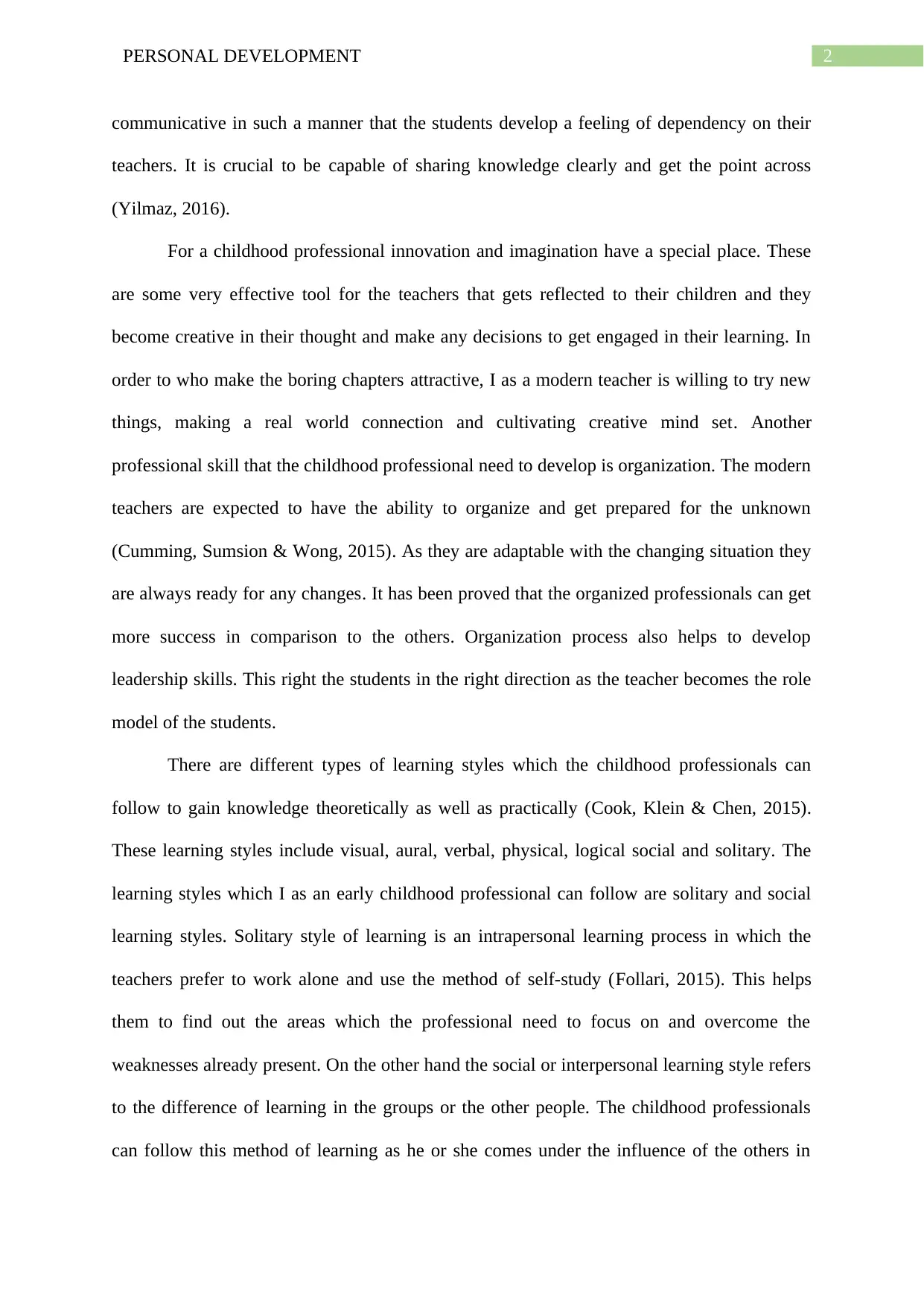
2PERSONAL DEVELOPMENT
communicative in such a manner that the students develop a feeling of dependency on their
teachers. It is crucial to be capable of sharing knowledge clearly and get the point across
(Yilmaz, 2016).
For a childhood professional innovation and imagination have a special place. These
are some very effective tool for the teachers that gets reflected to their children and they
become creative in their thought and make any decisions to get engaged in their learning. In
order to who make the boring chapters attractive, I as a modern teacher is willing to try new
things, making a real world connection and cultivating creative mind set. Another
professional skill that the childhood professional need to develop is organization. The modern
teachers are expected to have the ability to organize and get prepared for the unknown
(Cumming, Sumsion & Wong, 2015). As they are adaptable with the changing situation they
are always ready for any changes. It has been proved that the organized professionals can get
more success in comparison to the others. Organization process also helps to develop
leadership skills. This right the students in the right direction as the teacher becomes the role
model of the students.
There are different types of learning styles which the childhood professionals can
follow to gain knowledge theoretically as well as practically (Cook, Klein & Chen, 2015).
These learning styles include visual, aural, verbal, physical, logical social and solitary. The
learning styles which I as an early childhood professional can follow are solitary and social
learning styles. Solitary style of learning is an intrapersonal learning process in which the
teachers prefer to work alone and use the method of self-study (Follari, 2015). This helps
them to find out the areas which the professional need to focus on and overcome the
weaknesses already present. On the other hand the social or interpersonal learning style refers
to the difference of learning in the groups or the other people. The childhood professionals
can follow this method of learning as he or she comes under the influence of the others in
communicative in such a manner that the students develop a feeling of dependency on their
teachers. It is crucial to be capable of sharing knowledge clearly and get the point across
(Yilmaz, 2016).
For a childhood professional innovation and imagination have a special place. These
are some very effective tool for the teachers that gets reflected to their children and they
become creative in their thought and make any decisions to get engaged in their learning. In
order to who make the boring chapters attractive, I as a modern teacher is willing to try new
things, making a real world connection and cultivating creative mind set. Another
professional skill that the childhood professional need to develop is organization. The modern
teachers are expected to have the ability to organize and get prepared for the unknown
(Cumming, Sumsion & Wong, 2015). As they are adaptable with the changing situation they
are always ready for any changes. It has been proved that the organized professionals can get
more success in comparison to the others. Organization process also helps to develop
leadership skills. This right the students in the right direction as the teacher becomes the role
model of the students.
There are different types of learning styles which the childhood professionals can
follow to gain knowledge theoretically as well as practically (Cook, Klein & Chen, 2015).
These learning styles include visual, aural, verbal, physical, logical social and solitary. The
learning styles which I as an early childhood professional can follow are solitary and social
learning styles. Solitary style of learning is an intrapersonal learning process in which the
teachers prefer to work alone and use the method of self-study (Follari, 2015). This helps
them to find out the areas which the professional need to focus on and overcome the
weaknesses already present. On the other hand the social or interpersonal learning style refers
to the difference of learning in the groups or the other people. The childhood professionals
can follow this method of learning as he or she comes under the influence of the others in
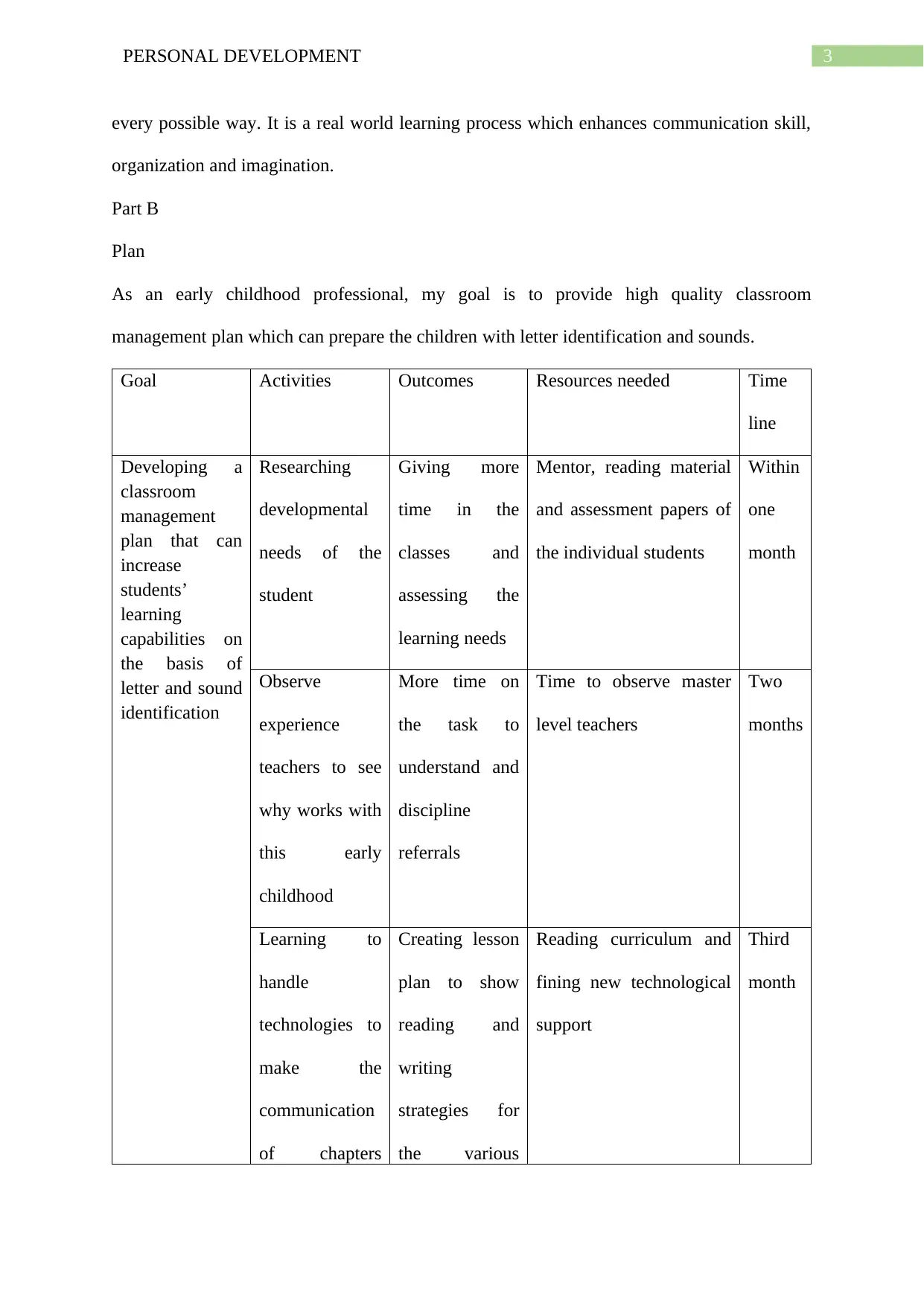
3PERSONAL DEVELOPMENT
every possible way. It is a real world learning process which enhances communication skill,
organization and imagination.
Part B
Plan
As an early childhood professional, my goal is to provide high quality classroom
management plan which can prepare the children with letter identification and sounds.
Goal Activities Outcomes Resources needed Time
line
Developing a
classroom
management
plan that can
increase
students’
learning
capabilities on
the basis of
letter and sound
identification
Researching
developmental
needs of the
student
Giving more
time in the
classes and
assessing the
learning needs
Mentor, reading material
and assessment papers of
the individual students
Within
one
month
Observe
experience
teachers to see
why works with
this early
childhood
More time on
the task to
understand and
discipline
referrals
Time to observe master
level teachers
Two
months
Learning to
handle
technologies to
make the
communication
of chapters
Creating lesson
plan to show
reading and
writing
strategies for
the various
Reading curriculum and
fining new technological
support
Third
month
every possible way. It is a real world learning process which enhances communication skill,
organization and imagination.
Part B
Plan
As an early childhood professional, my goal is to provide high quality classroom
management plan which can prepare the children with letter identification and sounds.
Goal Activities Outcomes Resources needed Time
line
Developing a
classroom
management
plan that can
increase
students’
learning
capabilities on
the basis of
letter and sound
identification
Researching
developmental
needs of the
student
Giving more
time in the
classes and
assessing the
learning needs
Mentor, reading material
and assessment papers of
the individual students
Within
one
month
Observe
experience
teachers to see
why works with
this early
childhood
More time on
the task to
understand and
discipline
referrals
Time to observe master
level teachers
Two
months
Learning to
handle
technologies to
make the
communication
of chapters
Creating lesson
plan to show
reading and
writing
strategies for
the various
Reading curriculum and
fining new technological
support
Third
month
Secure Best Marks with AI Grader
Need help grading? Try our AI Grader for instant feedback on your assignments.
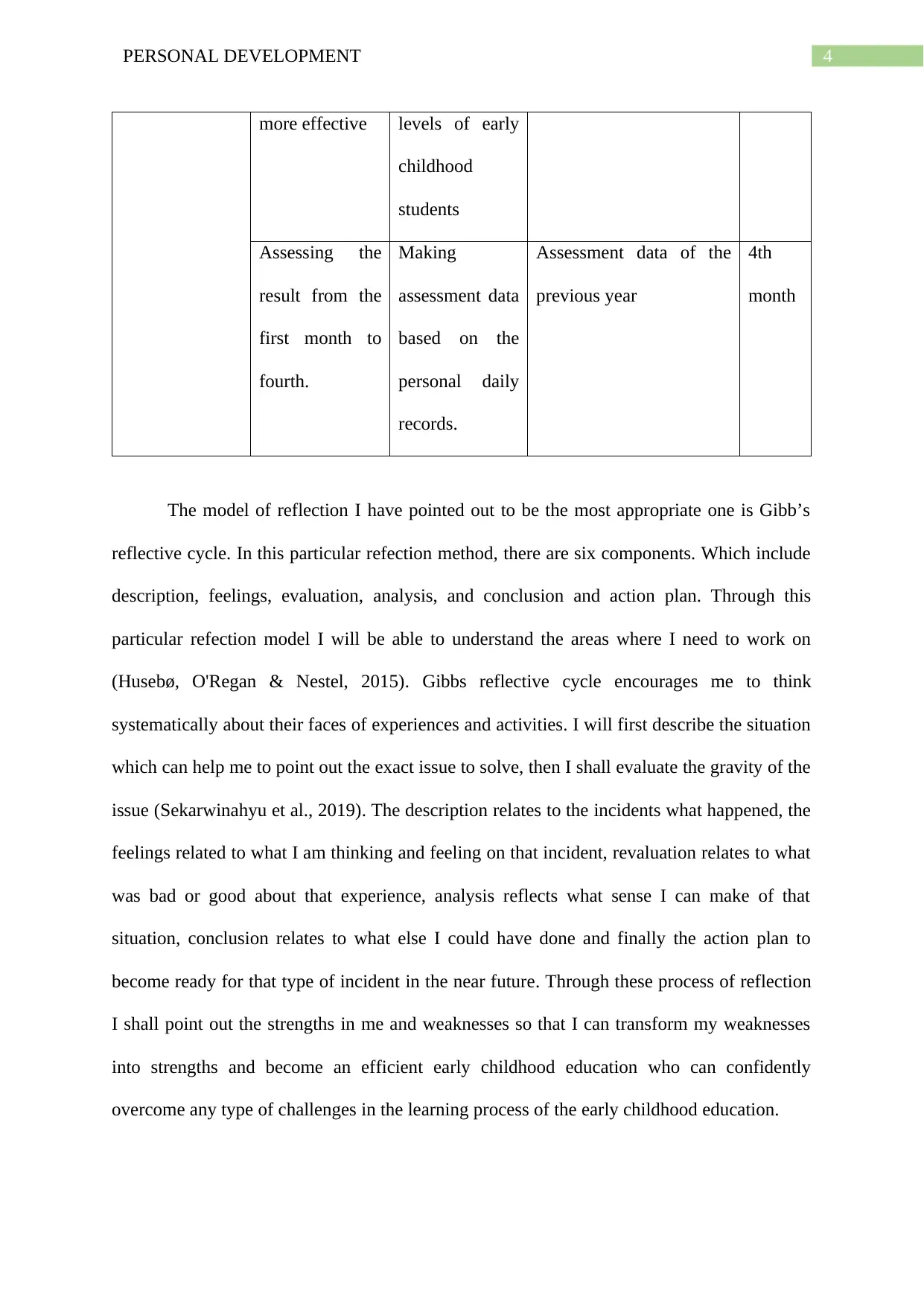
4PERSONAL DEVELOPMENT
more effective levels of early
childhood
students
Assessing the
result from the
first month to
fourth.
Making
assessment data
based on the
personal daily
records.
Assessment data of the
previous year
4th
month
The model of reflection I have pointed out to be the most appropriate one is Gibb’s
reflective cycle. In this particular refection method, there are six components. Which include
description, feelings, evaluation, analysis, and conclusion and action plan. Through this
particular refection model I will be able to understand the areas where I need to work on
(Husebø, O'Regan & Nestel, 2015). Gibbs reflective cycle encourages me to think
systematically about their faces of experiences and activities. I will first describe the situation
which can help me to point out the exact issue to solve, then I shall evaluate the gravity of the
issue (Sekarwinahyu et al., 2019). The description relates to the incidents what happened, the
feelings related to what I am thinking and feeling on that incident, revaluation relates to what
was bad or good about that experience, analysis reflects what sense I can make of that
situation, conclusion relates to what else I could have done and finally the action plan to
become ready for that type of incident in the near future. Through these process of reflection
I shall point out the strengths in me and weaknesses so that I can transform my weaknesses
into strengths and become an efficient early childhood education who can confidently
overcome any type of challenges in the learning process of the early childhood education.
more effective levels of early
childhood
students
Assessing the
result from the
first month to
fourth.
Making
assessment data
based on the
personal daily
records.
Assessment data of the
previous year
4th
month
The model of reflection I have pointed out to be the most appropriate one is Gibb’s
reflective cycle. In this particular refection method, there are six components. Which include
description, feelings, evaluation, analysis, and conclusion and action plan. Through this
particular refection model I will be able to understand the areas where I need to work on
(Husebø, O'Regan & Nestel, 2015). Gibbs reflective cycle encourages me to think
systematically about their faces of experiences and activities. I will first describe the situation
which can help me to point out the exact issue to solve, then I shall evaluate the gravity of the
issue (Sekarwinahyu et al., 2019). The description relates to the incidents what happened, the
feelings related to what I am thinking and feeling on that incident, revaluation relates to what
was bad or good about that experience, analysis reflects what sense I can make of that
situation, conclusion relates to what else I could have done and finally the action plan to
become ready for that type of incident in the near future. Through these process of reflection
I shall point out the strengths in me and weaknesses so that I can transform my weaknesses
into strengths and become an efficient early childhood education who can confidently
overcome any type of challenges in the learning process of the early childhood education.
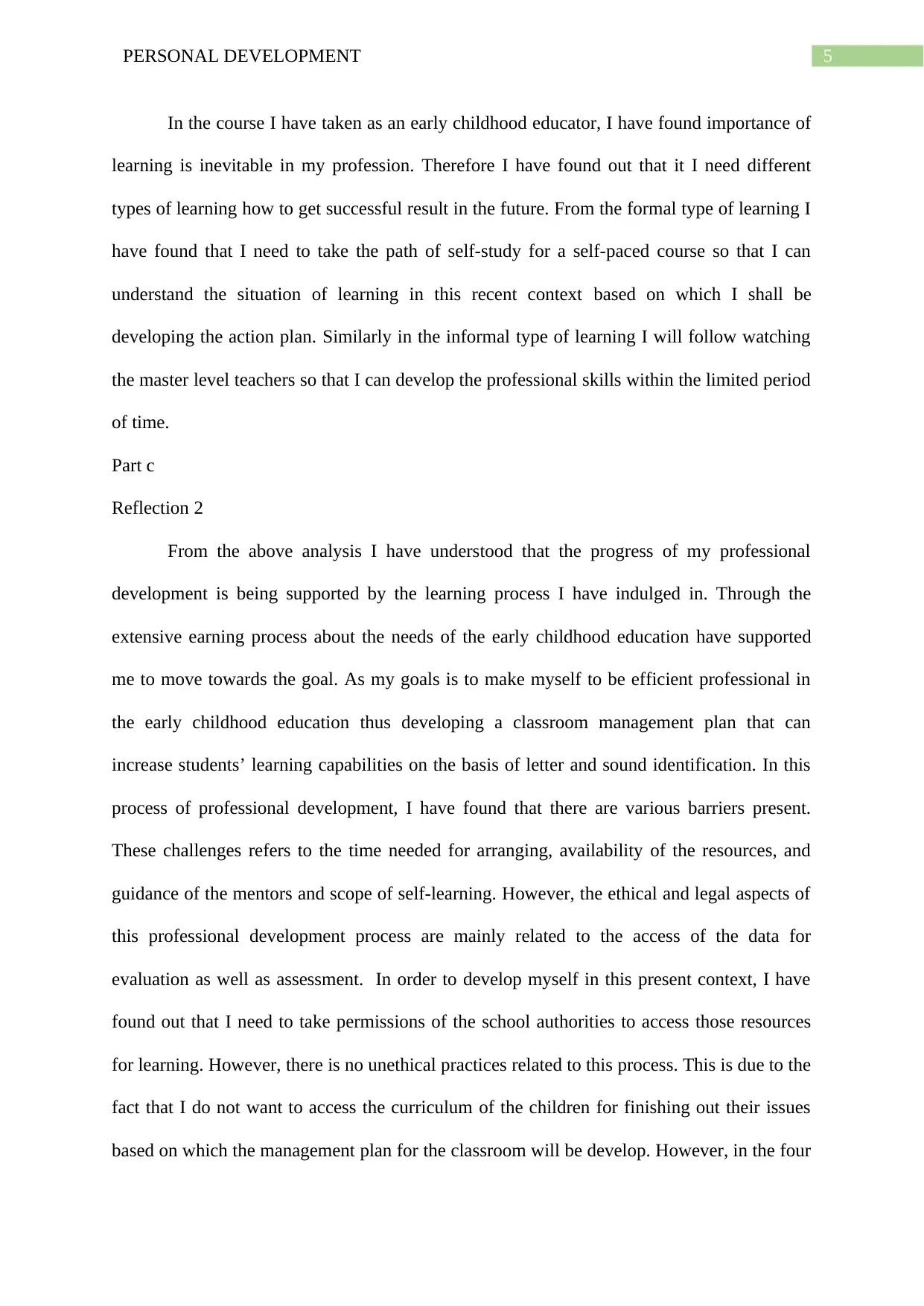
5PERSONAL DEVELOPMENT
In the course I have taken as an early childhood educator, I have found importance of
learning is inevitable in my profession. Therefore I have found out that it I need different
types of learning how to get successful result in the future. From the formal type of learning I
have found that I need to take the path of self-study for a self-paced course so that I can
understand the situation of learning in this recent context based on which I shall be
developing the action plan. Similarly in the informal type of learning I will follow watching
the master level teachers so that I can develop the professional skills within the limited period
of time.
Part c
Reflection 2
From the above analysis I have understood that the progress of my professional
development is being supported by the learning process I have indulged in. Through the
extensive earning process about the needs of the early childhood education have supported
me to move towards the goal. As my goals is to make myself to be efficient professional in
the early childhood education thus developing a classroom management plan that can
increase students’ learning capabilities on the basis of letter and sound identification. In this
process of professional development, I have found that there are various barriers present.
These challenges refers to the time needed for arranging, availability of the resources, and
guidance of the mentors and scope of self-learning. However, the ethical and legal aspects of
this professional development process are mainly related to the access of the data for
evaluation as well as assessment. In order to develop myself in this present context, I have
found out that I need to take permissions of the school authorities to access those resources
for learning. However, there is no unethical practices related to this process. This is due to the
fact that I do not want to access the curriculum of the children for finishing out their issues
based on which the management plan for the classroom will be develop. However, in the four
In the course I have taken as an early childhood educator, I have found importance of
learning is inevitable in my profession. Therefore I have found out that it I need different
types of learning how to get successful result in the future. From the formal type of learning I
have found that I need to take the path of self-study for a self-paced course so that I can
understand the situation of learning in this recent context based on which I shall be
developing the action plan. Similarly in the informal type of learning I will follow watching
the master level teachers so that I can develop the professional skills within the limited period
of time.
Part c
Reflection 2
From the above analysis I have understood that the progress of my professional
development is being supported by the learning process I have indulged in. Through the
extensive earning process about the needs of the early childhood education have supported
me to move towards the goal. As my goals is to make myself to be efficient professional in
the early childhood education thus developing a classroom management plan that can
increase students’ learning capabilities on the basis of letter and sound identification. In this
process of professional development, I have found that there are various barriers present.
These challenges refers to the time needed for arranging, availability of the resources, and
guidance of the mentors and scope of self-learning. However, the ethical and legal aspects of
this professional development process are mainly related to the access of the data for
evaluation as well as assessment. In order to develop myself in this present context, I have
found out that I need to take permissions of the school authorities to access those resources
for learning. However, there is no unethical practices related to this process. This is due to the
fact that I do not want to access the curriculum of the children for finishing out their issues
based on which the management plan for the classroom will be develop. However, in the four
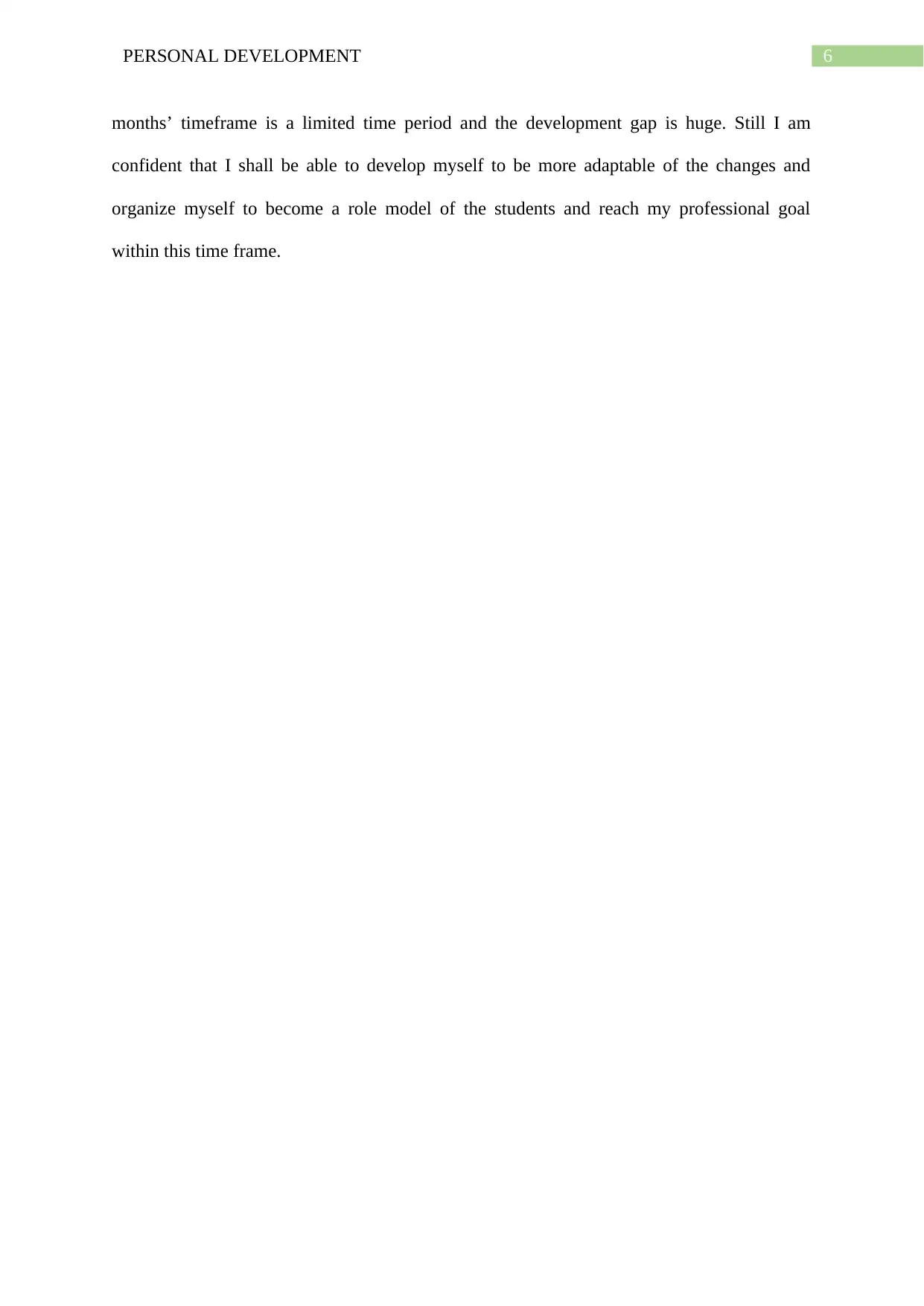
6PERSONAL DEVELOPMENT
months’ timeframe is a limited time period and the development gap is huge. Still I am
confident that I shall be able to develop myself to be more adaptable of the changes and
organize myself to become a role model of the students and reach my professional goal
within this time frame.
months’ timeframe is a limited time period and the development gap is huge. Still I am
confident that I shall be able to develop myself to be more adaptable of the changes and
organize myself to become a role model of the students and reach my professional goal
within this time frame.
Paraphrase This Document
Need a fresh take? Get an instant paraphrase of this document with our AI Paraphraser
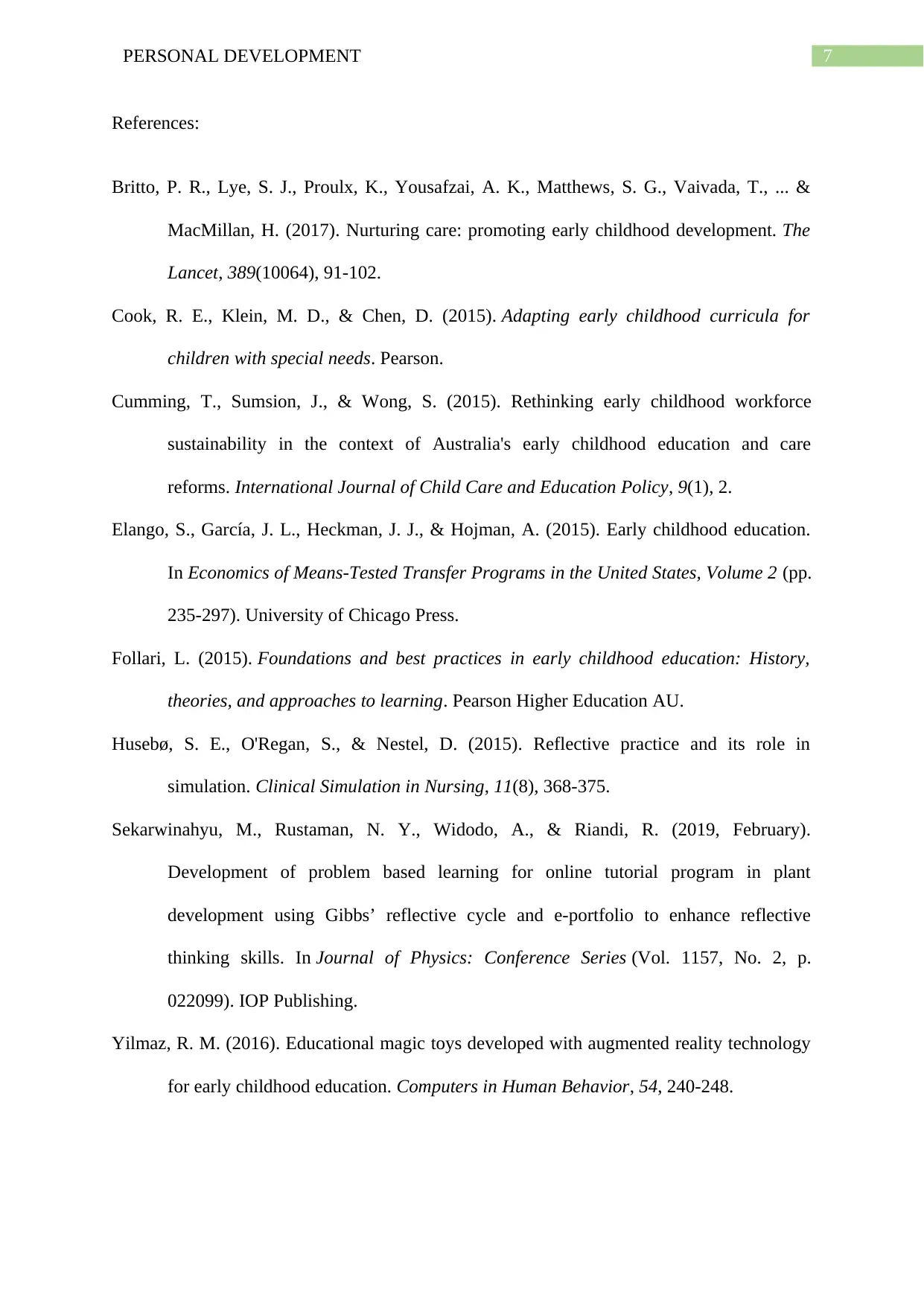
7PERSONAL DEVELOPMENT
References:
Britto, P. R., Lye, S. J., Proulx, K., Yousafzai, A. K., Matthews, S. G., Vaivada, T., ... &
MacMillan, H. (2017). Nurturing care: promoting early childhood development. The
Lancet, 389(10064), 91-102.
Cook, R. E., Klein, M. D., & Chen, D. (2015). Adapting early childhood curricula for
children with special needs. Pearson.
Cumming, T., Sumsion, J., & Wong, S. (2015). Rethinking early childhood workforce
sustainability in the context of Australia's early childhood education and care
reforms. International Journal of Child Care and Education Policy, 9(1), 2.
Elango, S., García, J. L., Heckman, J. J., & Hojman, A. (2015). Early childhood education.
In Economics of Means-Tested Transfer Programs in the United States, Volume 2 (pp.
235-297). University of Chicago Press.
Follari, L. (2015). Foundations and best practices in early childhood education: History,
theories, and approaches to learning. Pearson Higher Education AU.
Husebø, S. E., O'Regan, S., & Nestel, D. (2015). Reflective practice and its role in
simulation. Clinical Simulation in Nursing, 11(8), 368-375.
Sekarwinahyu, M., Rustaman, N. Y., Widodo, A., & Riandi, R. (2019, February).
Development of problem based learning for online tutorial program in plant
development using Gibbs’ reflective cycle and e-portfolio to enhance reflective
thinking skills. In Journal of Physics: Conference Series (Vol. 1157, No. 2, p.
022099). IOP Publishing.
Yilmaz, R. M. (2016). Educational magic toys developed with augmented reality technology
for early childhood education. Computers in Human Behavior, 54, 240-248.
References:
Britto, P. R., Lye, S. J., Proulx, K., Yousafzai, A. K., Matthews, S. G., Vaivada, T., ... &
MacMillan, H. (2017). Nurturing care: promoting early childhood development. The
Lancet, 389(10064), 91-102.
Cook, R. E., Klein, M. D., & Chen, D. (2015). Adapting early childhood curricula for
children with special needs. Pearson.
Cumming, T., Sumsion, J., & Wong, S. (2015). Rethinking early childhood workforce
sustainability in the context of Australia's early childhood education and care
reforms. International Journal of Child Care and Education Policy, 9(1), 2.
Elango, S., García, J. L., Heckman, J. J., & Hojman, A. (2015). Early childhood education.
In Economics of Means-Tested Transfer Programs in the United States, Volume 2 (pp.
235-297). University of Chicago Press.
Follari, L. (2015). Foundations and best practices in early childhood education: History,
theories, and approaches to learning. Pearson Higher Education AU.
Husebø, S. E., O'Regan, S., & Nestel, D. (2015). Reflective practice and its role in
simulation. Clinical Simulation in Nursing, 11(8), 368-375.
Sekarwinahyu, M., Rustaman, N. Y., Widodo, A., & Riandi, R. (2019, February).
Development of problem based learning for online tutorial program in plant
development using Gibbs’ reflective cycle and e-portfolio to enhance reflective
thinking skills. In Journal of Physics: Conference Series (Vol. 1157, No. 2, p.
022099). IOP Publishing.
Yilmaz, R. M. (2016). Educational magic toys developed with augmented reality technology
for early childhood education. Computers in Human Behavior, 54, 240-248.
1 out of 8
Related Documents
Your All-in-One AI-Powered Toolkit for Academic Success.
+13062052269
info@desklib.com
Available 24*7 on WhatsApp / Email
![[object Object]](/_next/static/media/star-bottom.7253800d.svg)
Unlock your academic potential
© 2024 | Zucol Services PVT LTD | All rights reserved.




